Contributory members are able to log private notes and comments about each site
Sites theCAptain has logged. View this log as a table or view the most recent logs from everyone
Roque Traoucado
Trip No.205 Entry No.99 Date Added: 9th Nov 2020
Site Type: Burial Chamber or Dolmen
Country: France (Languedoc:Aude (11))
Visited: Yes on 14th Sep 2005. My rating: Condition 2 Ambience 4 Access 4

Roque Traoucado submitted by thecaptain on 13th Mar 2006. Roque Traoucado, up on the southern slopes of the Montagne Noire in Minervois wine country.
The views from up here, over the plain of the Aude river are truly spectacular. On a clear day, the Mediterranean sea and the sacred mountain of Canigou in the Pyrénées are clearly visible.
(View photo, vote or add a comment)
Log Text: From the wine village of Villeneuve-Minervois, follow the little windy road northwards for about 4 kilometres into the hills towards Pujol-du-Bosc. This road up into the mountains is now a properly made up road, rather than the dirt track it was 6 years ago. Eventually you will find a parking area and a dolmen sign. Two little signposted walks are arranged, with all sorts of items of interest to see along the way, such as limestone ovens, shepherds huts, and many signs pointing out the various types of vegetation.
From the parking area take the short path to the left of the road, and you soon come to the remains of this dolmen, excavated in 1972. What you find is the remains of a round stone cairn, diameter about 18 metres and encircled by several large upright stones, with the remains of a chamber in the middle. The chamber is 4 metres in length, by 1 metre wide, and slab lined, but there are no capstones. There is an entry corridor, strangely oriented towards the southwest. Amongst items found here during the excavations were copper and bronze bracelets. Dating showed that the tomb was in use for a long time during the third millennium BC.
Dolmen de la Jagartière
Trip No.205 Entry No.100 Date Added: 9th Nov 2020
Site Type: Burial Chamber or Dolmen
Country: France (Languedoc:Aude (11))
Visited: Yes on 14th Sep 2005. My rating: Condition 5 Ambience 5 Access 4
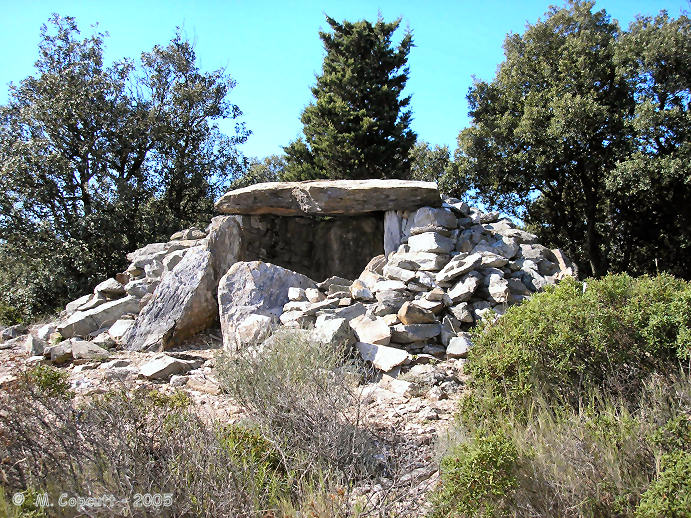
Dolmen de la Jagartière submitted by thecaptain on 20th Mar 2006. The slab sided chamber, 3 metres by 2 metres, is covered with a single large capstone, and has an entry looking over the Aude valley to the southeast at 160°. There is a small cairn surrounding the chamber, of which the excavations showed it to be of diameter only 8.5 metres, with an encircling circle of stones.
(View photo, vote or add a comment)
Log Text: From the wine village of Villeneuve-Minervois, follow the little windy road northwards for about 4 kilometres into the hills towards Pujol-du-Bosc. This road up into the mountains is now a properly made up road, rather than the dirt track it was 6 years ago. Eventually you will find a parking area and a dolmen sign. Two little signposted walks are arranged, with all sorts of items of interest to see along the way, such as limestone ovens, shepherds huts, and many signs pointing out the various types of vegetation.
From the parking area, take the path to the right from the car park, and after a few hundred metres you will find this splendidly restored dolmen, sitting with wondrous views over the Minervois countryside and the Aude valley to the south. As I sit and write this, theres lots of shouting and horns blowing, is there a hunt on, or is it just shepherds moving their flocks ? The slab sided chamber, 3 metres by 2 metres, is covered with a single large capstone, and has an entry looking over the valley to the southeast at 160°. There is a small cairn surrounding the chamber, of which the excavations showed it to be of diameter only 8.5 metres, with an encircling circle of stones.
It really is superb up here! There's Canigou in the distance to the southeast, and the Meditterranean sea can be seen shimmering on the horizon.
Malves Menhir
Trip No.205 Entry No.98 Date Added: 9th Nov 2020
Site Type: Standing Stone (Menhir)
Country: France (Languedoc:Aude (11))
Visited: Yes on 14th Sep 2005. My rating: Condition 4 Ambience 4 Access 4
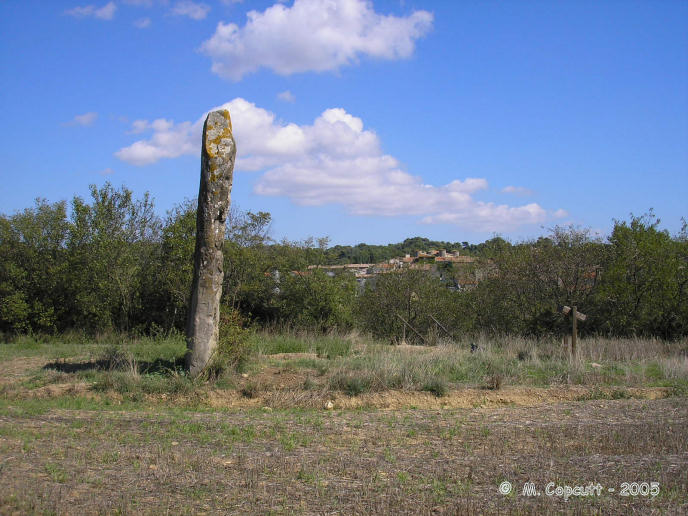
Malves Menhir submitted by thecaptain on 6th Mar 2006. The menhir is to be found a few hundred metres west of the winemaking village of Malves-en-Minervois, and just across the river from the central wine co-op.
Although it is over 5 metres high, it is less than half a metre thick.
(View photo, vote or add a comment)
Log Text: This large menhir is to be found a few hundred metres outside the village of Malves-en-Minervois, taking the D.38 road westwards towards Villalier, and just across the river. There is a little parking area, and a signposted walk for about 100 metres to the stone. Just how could I have missed this when I came to look 5 years ago ?
The stone stands proudly on a higher bit of ground above a vineyard, with steps up to the field it is in. It is over 5 metres high (with apparently 4 metres more under the ground), 1.5 metres in width but less than half a metre thick. It was restored in the 1960s and looks to have been mended from three broken pieces, although its possible that the cement like substance is perhaps just filling cracks.
Dolmen de la Madeleine d’Albesse
Trip No.205 Entry No.97 Date Added: 8th Nov 2020
Site Type: Burial Chamber or Dolmen
Country: France (Languedoc:Aude (11))
Visited: Yes on 14th Sep 2005. My rating: Condition 3 Ambience 4 Access 3

Dolmen de la Madeleine d’Albesse submitted by thecaptain on 7th Mar 2006. A few metres to the east of the main chamber is a slab lined pit in the mound, about a metre square and the same deep. Whether this was another part of the original tomb or not, I cannot tell.
(View photo, vote or add a comment)
Log Text: Walk just more than a kilometer southwest along the track along the top of the ridge from the bends in the D.3 road to the north of Monze. The dolmen can then be found in a bank to the left of the trackway, on top of the ridge.
I couldn’t be sure whether the dolmen was made on a natural ridge, or whether there is a large mound built around it, its probably a bit of both. The chamber itself is quite large, but a bit of a wreck these days. It looks to be a sort of V shaped chamber 6 metres in length and up to 3 metres wide and is open to the east at about 118°, which looks right along the valley below the ridge. Its quite a high chamber too, and there would be plenty of room to stand up within it. Unfortunately, although the sides are well defined, there is only one capstone, and this is dislodged to one side, near to the back of the chamber. A few metres to the east of the main chamber is a slab lined pit in the mound, about a metre square and the same deep. Whether this was another part of the original tomb or not, I cannot tell.
I have to say it was a pleasant walk along the ridge despite the intense heat, through lovely smelling pine and juniper scrub, with very pleasant views of rocky hills and vine rich valleys below. There is also lots of exotic insect life up here too, I disturbed a praying mantis at one point, which flew off in a flash of green. Just to the northwest of the dolmen and mound, it looks like there may well be another artificial mound, but this one is very overgrown and impossible to get onto to have a closer look.
Aqueduc d’Ansignan
Trip No.205 Entry No.95 Date Added: 7th Nov 2020
Site Type: Ancient Mine, Quarry or other Industry
Country: France (Languedoc:Pyrénées-Orientales 66)
Visited: Yes on 13th Sep 2005. My rating: Condition 4 Ambience 4 Access 4
Aqueduc d’Ansignan submitted by TheCaptain on 6th Nov 2020. Ancient bridge and aqueduct spanning the river below the village of Ansignan, the basis of which is a Roman bridge, probably from the 3rd century.
(View photo, vote or add a comment)
Log Text: Ancient bridge and aqueduct spanning the river at the village of Ansignan, still used to irrigate crops on the opposite bank. It is built on the basis of a Roman bridge, probably from the 3rd century.
To cross the bridge, with the aqueduct built on top, you walk within an enclosed passage with a few holes for light, and it seems rather like walking along a passage within the walls of a castle.
Dolmen de la Rouyre
Trip No.205 Entry No.94 Date Added: 5th Nov 2020
Site Type: Burial Chamber or Dolmen
Country: France (Languedoc:Pyrénées-Orientales 66)
Visited: Yes on 13th Sep 2005. My rating: Condition 3 Ambience 4 Access 3
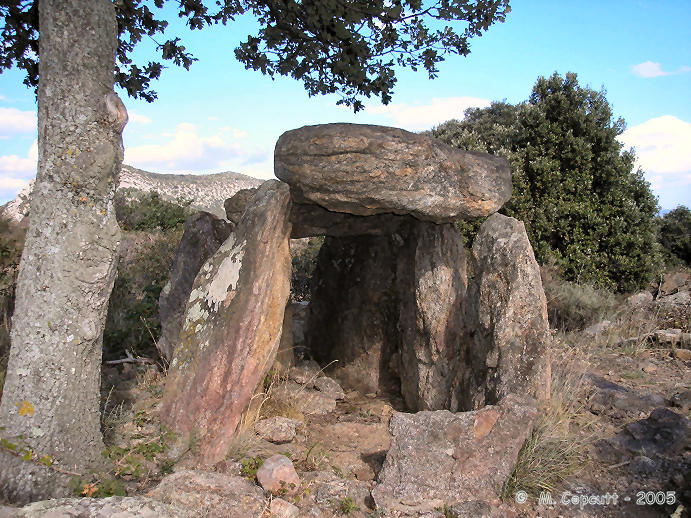
Dolmen de la Rouyre submitted by thecaptain on 10th Mar 2006. High up on this mountain ridge between the villages of Fesluns and Ansignan in Pyrénées-Orientales can be found the remains of this cute little dolmen.
Its a tiny little thing, just 2 metres in length by 1 metre wide, and a metre high.
(View photo, vote or add a comment)
Log Text: High up on this mountain ridge between the villages of Fesluns and Ansignan in Pyrénées-Orientales can be found the remains of this cute little dolmen. I followed signs from Ansignan, but walked because I was not going to get the camper van up the steep, tiny, windy little roads, but a small car would get fairly close. I had no idea how far it was going to be to the dolmen, and perhaps wouldn't have started out had I known in advance. It turned out to be almost an hour brisk uphill walk before I made it to the dolmen.
It's a tiny little thing, just 2 metres in length by 1 metre wide, and a metre high. Two small capstones rest on 3 and 2 side supports, with a back stone and a half height stone at the front. There is evidence of a stone cairn, with encircling larger stones, about 8 metres in diameter. The chamber opens to the southwest at 240°, but perhaps this is the back. Maybe some of the chamber has disappeared, and it is possible that there was an entry corridor towards the southeast, but it is very hard to tell.
Was it worth the couple of hours of steep uphill walk for the visit? yes and no. The views were lovely once up here, and there were some beautiful butterflies to be seen in amongst the vines near the top of the ridge. Apart from driving to a closer position in a small car, it is possible that you could approach this dolmen from the west, which may also make it much easier to find.
Dolmen d'A Fourna
Trip No.205 Entry No.93 Date Added: 5th Nov 2020
Site Type: Burial Chamber or Dolmen
Country: France (Languedoc:Pyrénées-Orientales 66)
Visited: Yes on 13th Sep 2005. My rating: Condition 4 Ambience 5 Access 3

Dolmen d'A Fourna submitted by thecaptain on 9th Mar 2006. About four hundred metres from the Creu de la Llosa dolmen, following the little footpath through the scrub to the southwest, is another dolmen.
This dolmen is in a round cairn about 8 metres in diameter, and has an entrance passageway, wider than the chamber, 4 metres long.
(View photo, vote or add a comment)
Log Text: About four hundred metres from the Creu de la Llosa dolmen, following the footpath through the scrub to the southwest (note, go back down the track for about 25 metres from the dolmen to find the path - it is not the "obvious" path leading away from the dolmen), around the southern side of the ridge, and you will find another dolmen of similar type.
This dolmen, which again I assume restored, is slightly smaller, in a round cairn about 8 metres in diameter. The dolmen chamber is about 2 metres long by 1 metre wide, and covered with two small capstones, sitting on blocky side supports, only to about 1.2 metres in height. It has an entrance passageway, wider than the chamber, which is 4 metres long and opens up on an alignment of 120°, directly pointing towards a large and significant mountain peak. The capstones are both engraved, the front, larger one having multiple cupules with the faintest of some lines and cupules, while the smaller backstone has an extremely clear cross, with maybe some other, more fainter markings.
What a lovely place it is up here, pity the sky is cloudy and the views unclear. It also makes me wonder just how many more of these dolmens there are to be discovered in the forests up on these mountains.
Dolmen de Serrat d'en Jacques
Trip No.205 Entry No.92 Date Added: 5th Nov 2020
Site Type: Burial Chamber or Dolmen
Country: France (Languedoc:Pyrénées-Orientales 66)
Visited: Yes on 13th Sep 2005. My rating: Condition 4 Ambience 5 Access 3
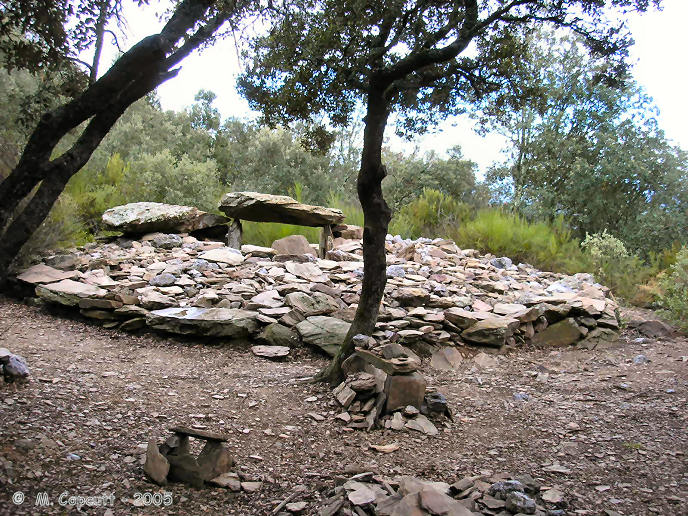
Dolmen de Serrat d'en Jacques submitted by thecaptain on 8th Mar 2006. A couple of hundred metres from the Creu de la Llosa dolmen, following the footpath uphill through the scrub to the east, and you can find another dolmen, similar in size, but this time with an entry passage through its cairn.
(View photo, vote or add a comment)
Log Text: A couple of hundred metres from the Creu de la Llosa dolmen, following the footpath uphill through the scrub to the east, up towards Serrat d'en Jacques, and you can find another dolmen, similar in size to the Creu de la Llosa dolmen, but this time with an entry passage through its cairn. I do not know the name of this dolmen, and I assume it has also been fairly recently restored.
The cairn is about 10 metres in diameter and surrounded by large slabs, with a height of about 0.5 metres. The dolmen, approximately central, has a chamber 3 metres long, and varying in width from about 1.8 m at the front to 1 m at the back. Again, the floor is paved, and there is a part height stone across the front. There are three side slabs each side, and a full height backstone. There were either several capstones, only one of which is now in position, or else a single large one has been broken. On top of the remains of the capstone are one or two cupules, but nothing much else in the way of engravings. To the southeast is an entrance chamber, facing 118°, paved and about 2.5 metres in length to the edge of the mound, making up to the full width of the chamber.
The views from this dolmen really are superb, but unfortunately slightly obscured by the highly scented scrubland. The Canigou is clearly visible to the southwest, but still enveloped in its clouds today. Excellent.
Dolmen de la Creu de Falibe
Trip No.205 Entry No.91 Date Added: 5th Nov 2020
Site Type: Burial Chamber or Dolmen
Country: France (Languedoc:Pyrénées-Orientales 66)
Visited: Yes on 13th Sep 2005. My rating: Condition 5 Ambience 4 Access 4
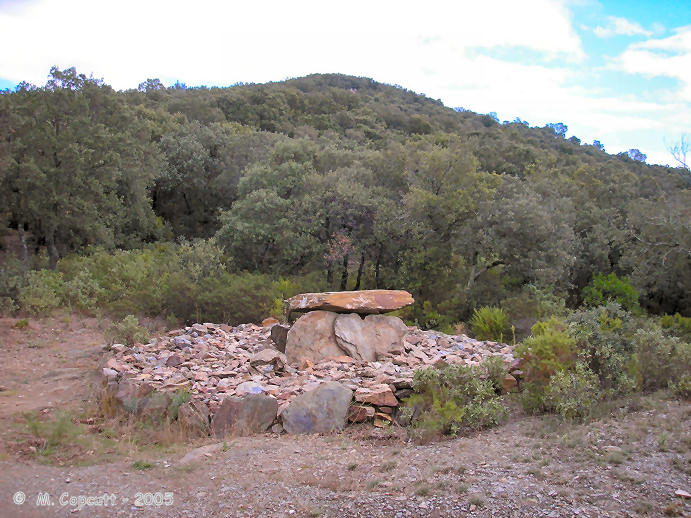
Dolmen de la Creu de Falibe submitted by thecaptain on 17th Mar 2006. This lovely restored dolmen in a round cairn with a heavily carved capstone can be found in the mountains to the south of the village of Saint-Michel-de-Llotes in Pyrénées-Orientales.
(View photo, vote or add a comment)
Log Text: This lovely restored dolmen can be found in the hills to the south of the village of Saint-Michel-de-Llotes. Travelling south, turn left at the village beside the Catalane museum, over the bridge. Follow this road for several kilometres, twisting and turning up into the mountains, to the Col de la Croix de la Falibe. Its further than you would think, and you even start going downhill again before you get there, but once there its obvious, and has a sign to the dolmen along the large track to the left, with plenty of room to park. If you're feeling adventurous, it would be possible to drive along this stoney track, as I was walking along it a car did in fact pass me.
Go about a kilometre along the track, and at the top of the ridge you will fond the dolmen, contained within its circular cairn. The chamber is rectangular, 2.5 m by 1.5 , surrounded on all four sides by upright slabs. The capstone is supported on the two long sides by the side slabs, while at the ends the slabs do not reach the top. The chamber is paved, and has a single capstone on top, which is only 2.5 metres by 1.5 metres, just big enough to cover the chamber. The capstone is heavily carved, and has many cupules, lines and crosses engraved into the top. The crosses are made by joining between 4 small cupules. Some of the cupules are quite large, up to 10 cm in diameter, and these larger cupules are linked together with larger engraved lines, making a sort of fish shape around the capstone. The whole top of the capstone is carved, and is most intriguing. The dolmen itself is contained within the remains of a stone cairn, about 10 metres in diameter, and with large stone edging all the way round.
This is a lovely place to visit, well worth the time, and the views nearby, although not from the dolmen itself, are splendid.
Peyro Dreta
Trip No.205 Entry No.90 Date Added: 28th Oct 2020
Site Type: Standing Stone (Menhir)
Country: France (Languedoc:Pyrénées-Orientales 66)
Visited: Yes on 12th Sep 2005. My rating: Condition 2 Ambience 3 Access 4

Peyro Dreta submitted by thecaptain on 3rd Mar 2006. This fallen and broken menhir, once more than 4 metres tall, has beautiful views over the Fenouillades valley to the north, with Queribus castle and Tautavel clearly visible.
(View photo, vote or add a comment)
Log Text: This fallen and broken menhir, once more than 4 metres tall, has beautiful views over the Fenouillades valley to the north, with Queribus castle and Tautavel clearly visible. The menhir can be found about a kilometres walk down a dirt track amongst the vines, about 0.7 kilometres to the west of the Col de Bataille. The start of the track is easy to find, as it is marked with a large menhir like stone at the junction beside the vineyards. Perhaps this stone itself was once a proper menhir, which has now been re-erected.
Moli del Vent
Trip No.205 Entry No.89 Date Added: 28th Oct 2020
Site Type: Burial Chamber or Dolmen
Country: France (Languedoc:Pyrénées-Orientales 66)
Visited: Yes on 12th Sep 2005. My rating: Condition 5 Ambience 5 Access 4

Moli del Vent submitted by thecaptain on 3rd Mar 2006. The little chamber is approached from the south by a corridor from the edge of the cairn, made with a few upright slabs and drystone walling.
The chamber is topped by a gorgeously shaped capstone
(View photo, vote or add a comment)
Log Text: At the top of the hill to the north west of the village of Bélesta can be found the superb but restored remains of this lovely little dolmen-a-couloir. The little chamber is about 2 metres by 1 metre, and the south side is approached by a corridor 5 metres long from the edge of the cairn, made with a few upright slabs and drystone walling. The chamber has an upright slab at each side, and two back slabs, topped by a gorgeously shaped capstone about 3m by 2m. The whole thing is contained within a round cairn, about 9 metres in diameter and 0.5 metres high.
The views from up here are superb, the Fenouillades valley to the north, and the Canigou brooding in amongst the clouds to the south west today. The dolmen is less than a kilometre walk up a good track from a junction of minor roads with plenty of space for parking, and is well worth the effort. It is possible that there are remains of other monuments round the area.
Tautavel Musee de Prehistoire
Trip No.205 Entry No.85 Date Added: 28th Oct 2020
Site Type: Museum
Country: France (Languedoc:Pyrénées-Orientales 66)
Visited: Yes on 12th Sep 2005. My rating: Condition 4 Ambience 3 Access 4
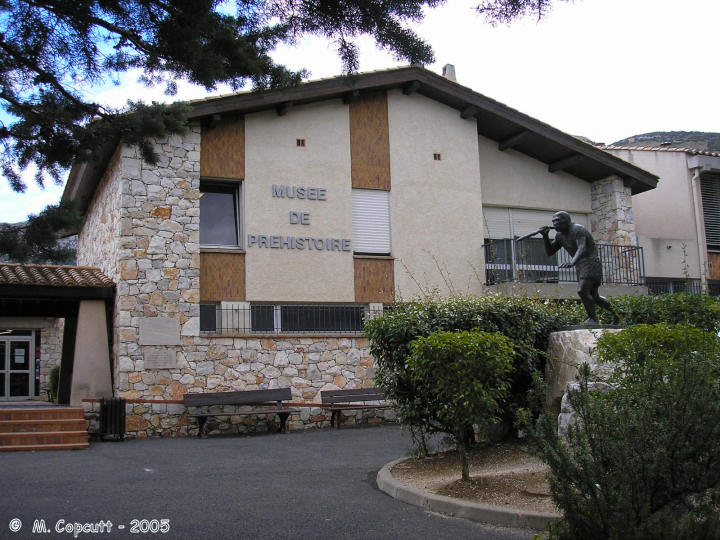
Tautavel Musee de Prehistoire submitted by thecaptain on 16th Dec 2005. Museum in the village of Tautavel in the French departement of Pyrénées-Orientales, which is the home to one of the oldest known European Humans.
(View photo, vote or add a comment)
Log Text: I only came here to get a photo, assuming the museum would be closed on a Monday, but it was open, so thought I'd better go in. The museum contains hundreds of thousands of items found at the nearby Caune de l'Arago cave, where the remains of a human skull was found in July 1971, the skull being known as Arago item 21. Since then many others have been found, along with items of their food, tools etc etc. The finds have been dated to about 450,000 BC, and thus are amongst the earliest remains of humans found in Europe.
Tautavel man lead a life of hunting, and this is all displayed here also, with remains of many animals and suchlike which would have been around at that time. Tautavel man, however, is not an ancester of ours, as he lead up to Neanderthal man, which died out 30,000 years ago, to be replaced by Cro Magnon man.
While this should all have been very interesting, I have to admit to finding many of the displays quite dull and repetitive, and the awful American voice talking down to me in the audio guide was enough to put me right off. The whole museum seemed a bit 1970's and showing signs of age. The displays mostly consisted of bones and tools in glass cases, video presentations of certain things, and staged scenes using mannequins, with lots of keep off and don't touch signs. In my recent travels, I have seen many much better presented museums which bring the subject to life.
Grand Menhir de Counozouls
Trip No.205 Entry No.84 Date Added: 28th Oct 2020
Site Type: Standing Stone (Menhir)
Country: France (Languedoc:Aude (11))
Visited: Yes on 12th Sep 2005. My rating: Condition 4 Ambience 4 Access 4
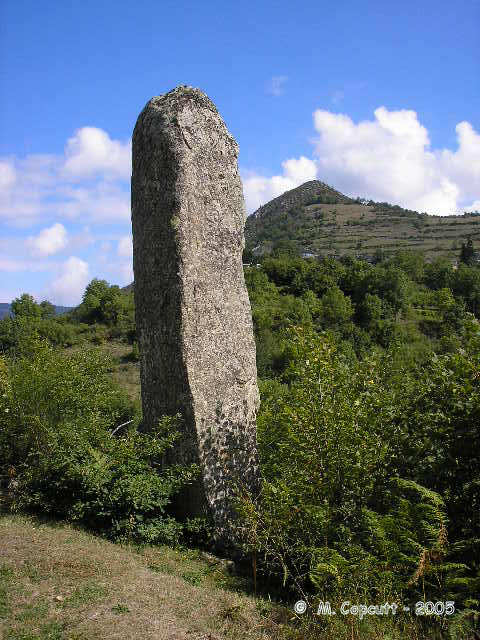
Grand Menhir de Counozouls submitted by thecaptain on 15th Nov 2005. Le Grand Menhir de Counozouls, the largest in southern France, stands at 8.9 metres tall.
(View photo, vote or add a comment)
Log Text: After a seemingly very long drive south from Quillan, along roads hacked into cliff faces, passing through numerous massive gorges which at times I never thought the campervan would fit through, I arrived at the village of Ste Colombe-sur-Guette. A few more miles south along the road in the valley, then climbing steeply up the side of the gorge, all the time bearing in mind theres a 3 metre height limit signposted, but which thankfully turns out to be only at one side of the road. Turn left and cross the bridge towards Cournozouls, and go a further 1.7 kilometres, until you come to a double right hand bend.
There is room to park here on the outside of the curve, and just here can be found this massive menhir, standing below the road on the steep hillside, with a little path leading down to it, and thankfully the trees around it now cleared. The stone now stands proudly in the open, with a lovely view of the village across the valley. The stone stands over 8 metres in height, making it the biggest in southern France, and one of the tallest in the entire country. It is a large granite lump, and initially looks a bit like it might be a natural lump fallen down the mountain. However it certainly looks to have been shaped, and wedged into its upright position, and I am assured it is a proper menhir.
Allée couverte de Mélus
Trip No.203 Entry No.574 Date Added: 28th Oct 2020
Site Type: Passage Grave
Country: France (Bretagne:Côtes-D'Armor (22))
Visited: Yes on 25th Jun 2005. My rating: Condition 3 Ambience 3 Access 4

Allée couverte de Mélus submitted by TheCaptain on 28th May 2007. The monument is now contained within a little walled area in some fields, a couple of hundred metres from a parking area.
(View photo, vote or add a comment)
Log Text: Despite looking very difficult to get to on the maps, this allée couverte is actually very easy to find, as a new housing development has been made, with the roads through it signposted to the allée couverte, and then a little trackway made up to it. The monument is now contained within a little walled area in the fields, a couple of hundred metres from a parking area.
It is about 14 metres long, with an orientation of 110°, with the entrance on the southern side, about two thirds the way along from the western end. The passageway is about 1.5 metres wide and less than a metre high, and still covered with nine capstones. Traces of a mound exist, particularly at the west end.
It looks to me as though it has been messed about with substantially, and maybe rebuilt fairly recently, as lots of the stones have sharpish edges, and don't look weathered right. It is also suffering from being where it is, and it is now a bit of a childrens playground, with the rubbish and suchlike that that entails. Still, it is here with us today.
Carnac Pyrénéen
Trip No.205 Entry No.65 Date Added: 26th Oct 2020
Site Type: Stone Circle
Country: France (Midi:Haute-Garonne (31))
Visited: Yes on 9th Sep 2005. My rating: Condition 4 Ambience 5 Access 3

Carnac Pyrénéen submitted by thecaptain on 8th Oct 2005. The most significant circle in the larger group of Cromlechs up on Mail de Soupene mountain high up above Bagneres-de-Luchon.
(View photo, vote or add a comment)
Log Text: Blimey, its almost sunny. In fact it is sunny at the tops of the mountains. I'd better get a move on. A bakers van comes round the camp site which is a help. Put last nights wet stuff outside to dry off. Leave the campsite by 10:00 and drive to Benque. Unfortunately I cannot park where I want to. Look at the maps and go elsewhere where I can park at the edge of the main road a bit further up the valley, and start walking up a different path. It is now warm and sunny, so I change back into shorts and techno shirt. Pack bag, boots on and away by 10 to 11.
The route is along a flat track at first, and then it joins with the path I would have been on at the edge of the village. The path is now quite steep, zig zagging up the side of the mountain, but its a well used track with occasional signs. I get to the first set of cromlechs at 11:45. The views from up here are beautiful all around, and there are all sorts of big birds flying around, and mushrooms etc. There are a few of the autumn crocus flowers looking to poke their heads out and bloom. The only other people around are 4 English people, who I saw parking where I had wanted to in the village. Cars will fit there, but not camper vans.
The 4 English people join me at the circles and we chat a bit. They are out walking and looking at the birds. Probably about my age and out here on a months holiday! There are lots of vultures about just above us. There is a sheep carcas further up the hill that they are after, but there is a dog up there also, so the vultures are circling, waiting... They have counted over 60 of them. A fantastic sight.
On the way back from here there are lots of those lovely flat thistle flowers out, and also some of the autumn crocus. This morning they were just pushing their heads through the soil, but now they are in full flower. Beautiful. It was a wonderful few hours up here in the hills, but now I have to get on. The weather has now cleared enough that I can see some glaciers up on the distant ridge. I get back down to the van just after 4:00, and decide to move on. I decide to head for Spain, over the Col du Portillon, which doesn't seem too far up, but its a massive drop down the other side into Spain.
L'alignement d'Espiaub
Trip No.205 Entry No.68 Date Added: 26th Oct 2020
Site Type: Stone Row / Alignment
Country: France (Midi:Haute-Garonne (31))
Visited: Yes on 9th Sep 2005. My rating: Condition 3 Ambience 5 Access 3

L'alignement d'Espiaub submitted by thecaptain on 8th Oct 2005. A view looking up the most readily identifiable stone row on Mail de Soupene mountain high up above Bagneres-de-Luchon.
This row is perhaps double, with a possible parallel row just at the edge of and in the bracken to the left.
(View photo, vote or add a comment)
Log Text: I have seen nothing definite about what is to be found up here, but it is possible to imagine/envisage that there are perhaps 4 or 5 lines of stones running across the hillside, with one or more crossing them, but it is very difficult to know exactly what is what. I walked down from the second set of cromlechs to something I could see, and found a manhole cover for a little cattle trough reservoir !
Looking back up the hillside from here, I would swear that I can see lines of stones coming down the hill from the first set of cromlechs. The stones are all in the bracken, but the bigger stones stand out above this. I think I can see 4 or 5 parallel rows of stones running down the hillside, with the stones looking evenly spaced. They extend to beyond where I am - perhaps 500 metres or more in total length, and I would estimate about 20 metres between rows. This is very difficult to photograph. But am I seeing things ? Not for nothing is there something up here called the Espiaube alignments.
While searching around on the slopes for closer signs of the parallel rows, and I still believe that I can see them, I clearly see a row running up and down the slope, across the lines of possible alignments. The top of the row starts at a spring, which has several large stones standing within a little pool, and continues downslope for about 100 metres, with perhaps more lost in the thick bracken. The stones are spaced evenly, about 8 metres apart from each other. I started to count the stones while walking up from the bottom, but part way up I am sure I saw another line running in parallel with the obvious one. The second line is in the bracken, while the first is in clear grass, as if lots of people have walked up and down here. This all reminds me very much of various Dartmoor and Exmoor rows.
Mail de Soupène Cromlechs
Trip No.205 Entry No.67 Date Added: 26th Oct 2020
Site Type: Stone Circle
Country: France (Midi:Haute-Garonne (31))
Visited: Yes on 9th Sep 2005. My rating: Condition 4 Ambience 5 Access 3

Mail de Soupène Cromlechs submitted by TheCaptain on 24th Jul 2007. My little rough sketch plan of the Mail de Soupène Cromlechs.
For my notes of the circles, see the site page details.
(View photo, vote or add a comment)
Log Text: Wow ! A bit further down the hill to the east, on a little upland ridge, is a row of stone circles all interlocking with each other. I counted 14 cairn circles up here, sort of joined together in a line along a little hillock. Fantastic. The largest one is on the top of the hillock, and there a row of others running from it down the ridgetop. Then there are other smaller circles built in between the larger ones.
Some of these circles have very well defined cists in their centre - indeed a couple of the smaller, lower circles still have slab lined boxes with both floor and capstones still in place. The top circle has a diameter of 7 metres, and is nicely formed with 23 stones making up the circumference with just a few gaps. There is nice flat grass within but no other obvious features. There are too many circles to write about individually, so I will just list the basic details of the circles I saw in a table below, with numbers matching the little sketch plan.
There is possibly a lot more remains here in the bracken, and not so well defined, and difficult to find.
Sarrat de Cousseillot Cromlechs
Trip No.205 Entry No.66 Date Added: 26th Oct 2020
Site Type: Stone Circle
Country: France (Midi:Haute-Garonne (31))
Visited: Yes on 9th Sep 2005. My rating: Condition 4 Ambience 5 Access 3
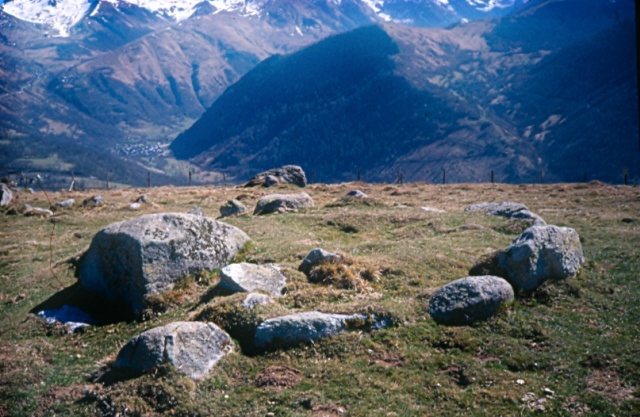
Sarrat de Cousseillot Cromlechs submitted by ocdolmen on 5th Aug 2009. Site in Midi: Haute-Garonne (31) France: Larboust site near Benqué village.
(View photo, vote or add a comment)
Log Text: The first cromlechs I arrive at are about 200 metres from the track, and signposted down a little footpath past some sheep pens at 1345 metres altitude. I saw 4 cairn circles up here, plus perhaps one large open circle. At first I thought I had seen a big open circle, but I am not completely sure. If it is one, it is made of natural rocks pushed into position, with a diameter of about 40 metres, and the stones 8 to 10 metres apart. I will look at this more later.
Just beyond the first fence is a group of 4 cromlechs on the ridgetop. The uppermost is diameter 6 metres and a nicely formed circle using a couple of large natural rocks. There are 19 tightly packed stones around the circumference, and the ground level is substantially higher within. The next nearest cromlech is a small circle 2.5 metres in diameter, with 12 stones around the circumference, and again the ground level is higher within than outside. This is right adjacent to the third cromlech, again 6 metres in diameter and there are 17 visible stones surrounding slightly higher ground within. In the centre of this ring are a few stones which probably once made up a burial cist. One or two of the stones in this circle are quite large, up to 1 metre high.
The fourth cromlech, a bit further down the hillside, is a bit ruinous. 5 metres in diameter, the upper half is well defined, but the lower half is just big natural rocks and a few packing stones. There are 18 stones still to be seen making up this circle, and again a possible burial cist in the middle.
Armenteule Menhir
Trip No.205 Entry No.64 Date Added: 25th Oct 2020
Site Type: Standing Stone (Menhir)
Country: France (Midi:Hautes-Pyrénées (65))
Visited: Yes on 8th Sep 2005. My rating: Condition 4 Ambience 4 Access 4
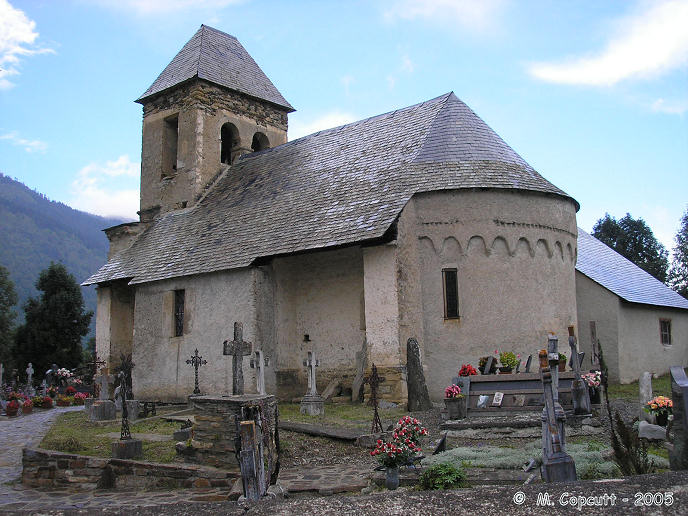
Armenteule menhir submitted by thecaptain on 7th Feb 2006. Deep in the Louron valley, on the western side of the Col de Peyresourde in the high Pyrenees, is the tiny village of Armenteule.
In this sleepy little Pyrenean village there is an old church. Inside the churchyard, just beside the back of the church, is a standing stone....
(View photo, vote or add a comment)
Log Text: Deep in the Louron valley, on the western side of the Col de Peyresourde in the high Pyrenees, is the tiny village of Armenteule. In this sleepy little Pyrenean village there is an old church. Inside the churchyard, just beside the back of the church, is a standing stone. Whether the church was built beside the menhir, or the stone was brought here later I do not know.
The stone is a piece of slatey schist, stands some 1.3 metres tall, and is approximately 40 cm wide by 20 cm thick at the base, tapering slightly to the top. The whole place has a nice feel about it, as if its as old as the hills, and that man has been living and farming here for eternity. It is slightly strange that this stone (and that at nearby Aneran) is made of a dark grey / black slatey stone, when the majority of stone round here is pale granite.
Aneran stone
Trip No.205 Entry No.63 Date Added: 25th Oct 2020
Site Type: Standing Stone (Menhir)
Country: France (Midi:Hautes-Pyrénées (65))
Visited: Yes on 8th Sep 2005. My rating: Condition 3 Ambience 3 Access 4

Aneran stone submitted by thecaptain on 22nd Jan 2006. The prehistoric stone here is the dark grey cylindrical block, stood beside the buttress at the rear corner of the church.
It's about 1.2 metres tall, and approximately circular in section with about 30 cm diameter. It reminds me a bit of some of the iron age steles in Brittany.
(View photo, vote or add a comment)
Log Text: Deep into the Louron valley, on the western side of the Col de Peyresourde in the high Pyrenees, is the tiny village of Aneran. In the tiny churchyard beside this small ancient church in this little Pyrenean village are several odds and ends of old stone, some carved into shapes and and with patterns on them.
I assume the prehistoric stone here is the dark grey cylindrical block, stood beside the wall at the corner of the church. Its about 1.2 metres tall, and approximately circular in section with about 30 cm diameter. It reminds me a bit of some of the iron age steles in Brittany. The church also has some fascinating carved stones built into its walls. An interesting little place.
